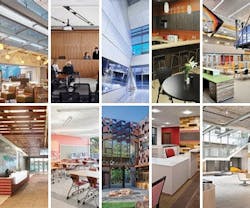Top 10 LEED Projects of 2012
As we sat down to sort through the dozens of submissions we received for our annual roundup of the best LEED projects of the year, we felt compelled to consider how the recent controversies over the LEED rating system had changed what it means to be LEED certified. As our knowledge of sustainability has grown, does the LEED system still represent the best way forward?
For critics and detractors of LEED, the answer is (and likely has been) no. To this group, the decision by the U.S. Green Building Council (USGBC) to delay balloting on the next generation of the rating system, LEED 2012 (now dubbed LEED v4), was proof that it had gone too far, too fast. What started 12 years ago as an elegant, simple blueprint for greening our buildings had metastasized into a lumbering, complex system favoring some constituents while alienating others—it had become, according to one manufacturer we recently spoke with, a “tax code with a great marketing campaign.”
For LEED devotees—including sustainability guru, Penny Bonda, who also writes about the controversies in this month’s EnvironDesign Notebook column—the pushback against the changes proposed in LEED v4 was more about a well-financed and organized opposition than a referendum on the system as a whole. As the rating system matures and evolves, it aims to eliminate more of the toxic chemicals and materials that still fill our interiors; for LEED supporters, the recent stumbles over approving a new version of the system are proof only that entrenched business interests will work tirelessly to protect their status quo.
We here at Interiors & Sources like to think that the truth lies somewhere in the middle. The LEED rating system has spread like wildfire across the globe—with more than 2 billion square feet of certified space in 130 countries—because it provides a blueprint for creating happier, healthier environments without one-size-fits-all mandates. It has made us more aware of the choices we make in the design process, and by extension, has fundamentally changed how we look at the spaces that we inhabit. That’s a good thing.
Of course, with change comes conflict, and LEED is no different. What began with the feeling and drive of a grassroots push for sustainability has evolved into an industry in its own right. With more people and organizations being impacted by the LEED system each day—the Green Building Certification Institute (GBCI) says there are currently more than 94,000 LEED APs in the world—it’s easy to see how problems arise with changes to the system. Compromise will be needed, and communication will be vital. But until a rival system renders LEED obsolete, it’s really all we’ve got. That means designers looking to further the goal of sustainability will need to work within the existing framework to keep pushing it forward.
In that spirit, we have selected our Top 10 LEED Projects of the Year with an eye towards those that point to the next generation of sustainability: buildings that slash their energy requirements through photovoltaics and cutting-edge geothermal systems; schools that teach sustainability by measuring their carbon footprint; and offices built in repurposed spaces that others had given up on.
These projects, taken from a cross-section of market sectors and locations, represent just what can be accomplished when we put our heads together. Hopefully, no matter what side of the debate you find yourself on, you can agree with that.
